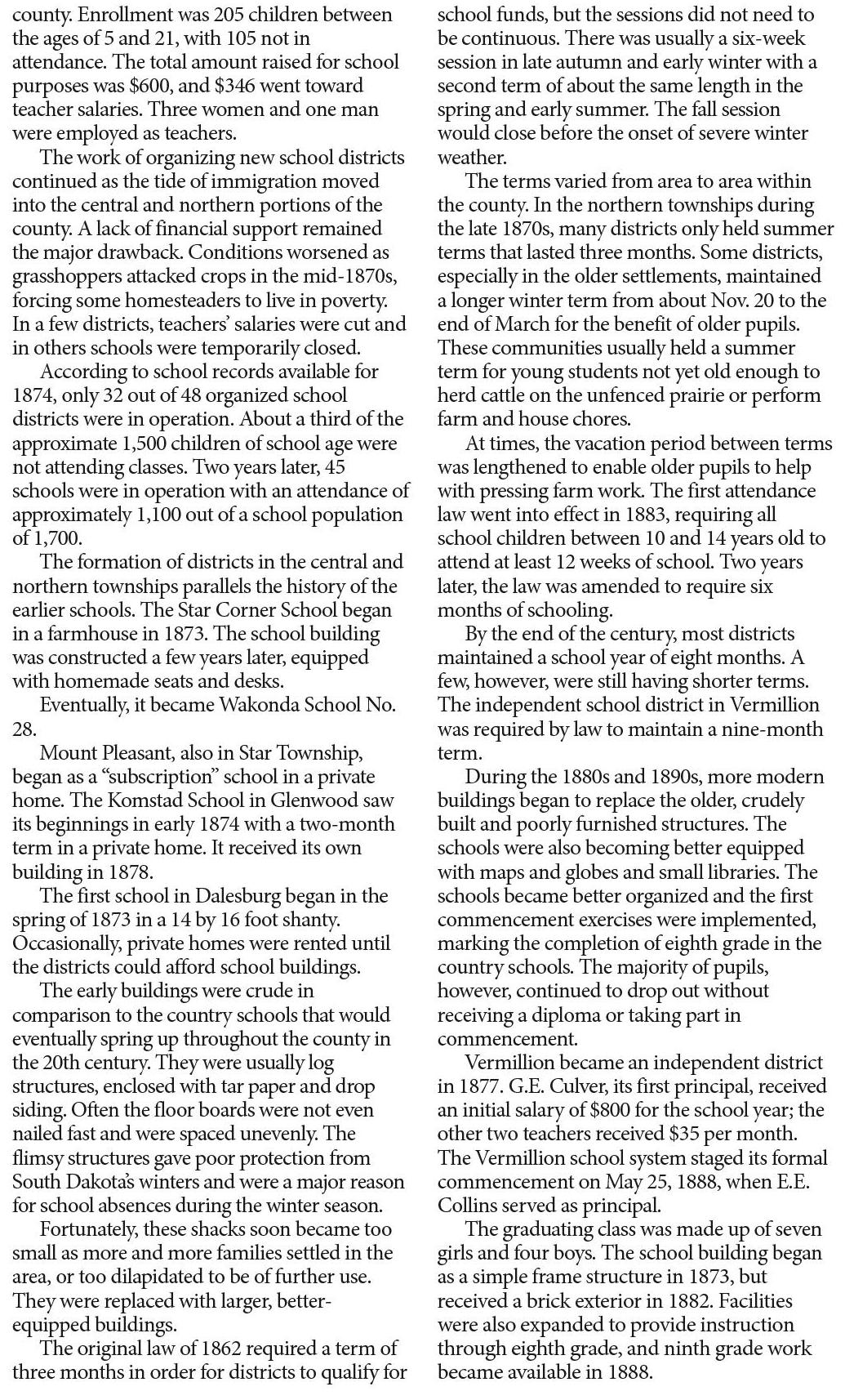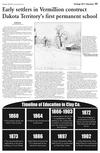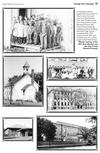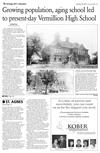4



04 Heritage 2011: Education
Timeline of
Education in
Clay Co.
1911
• Church Street School is
rebuilt.
• Additions made to Austin
and Jolley elementaries.
1919
• Some area schoolhouses
begin consolidating with the
Wakonda School Dist. and
the Meckling Independent
School Dist. This continues
until the late 1950s.
1920
• Meckling High School is
established.
1921
• Additions to Church Street
School.
1935
• Greenfield School No. 18 located near the Prairie
Center Township - is
destroyed by fire. A new
schoolhouse is built the
following year.
1939-53
• At least 16 of the area
country schools close
permanently.
October 28, 2011 www.plaintalk.net
Crude country schools dot
landscape with influx of settlers
By David Lias
david.lias@plaintalk.net
By December 1866, public school districts
had replaced the private schools in what was to
become Clay County. The official records for
that year indicate five organized districts with
an enrollment of 200 for the entire county –
110 males and 90 females. Out of a total
expenditure of $580, the amount of $500 was
raised by subscription.
The old log building, the first permanent
schoolhouse in Dakota Territory, was replaced
in 1873 by a two-story building on Court Street
in Vermillion on land donated by Nelson
Miner. The new structure had two rooms on
each floor and formed the base for various
additions and alterations in later years.
Some of the teachers of that era have names
with a familiar ring yet today: Amos Shaw and
Sarah Baker, John L. Jolley and Rachel Ross
who later was married to H.J. Austin.
While the new school was being built above
the bluff during the winter of 1872-73, classes
were held in two rented second-floor rooms in
what was called the Lyon Block.
In 1862, the territorial legislature passed
laws that created the first public school districts
in the region. Under the procedure provided by
the statute, the county superintendent laid out
the boundaries of a district and then ordered an
election so that voters may select school
officials, including a director, treasurer, and a
clerk. Described as the “New England” type of
district school government, it became
established by law in Dakota Territory.
These first school districts began with
practically no public support at first. According
to Herbert Schell, no school tax had been levied
and no school monies of any kind had been
collected in the counties. Also, no attempt had
been made to collect the dollar poll tax
authorized by law in 1863, and peace officers of
the various counties had failed to collect fines
which would have gone into the education
fund.
In 1866, the Clay County Commission
arbitrarily carved the county into five school
districts. It was a move that settlers near
Vermillion found unacceptable. Franklin
Taylor, the newly appointed superintendent,
redefined the boundaries of what would
become the first district.
Soon, a few small school buildings – the first
“country schools” in this region of Dakota
Territory, began to dot the landscape.
Taylor’s action resulted in the creation of
School No. 1, located in Vermillion Township a
mile north of town. The school was in
operation during 1867. A community along
Clay Creek in Spirit Mound Township became
the second district. A site for the school
building was selected along the bluff road
approximately in the center of the district.
District No. 3 was formed in Norway
Township. The site for the first building was a
short distance east of Bergen Church.
Superintendent Taylor called the citizens of the
community together for an organizational
meeting on Feb. 20, 1866. Ole Bottolfson was
elected director, and settlers immediately began
to make arrangements for a school, unwilling
to wait until school funds would become
available.
An 18-by-24-foot building was constructed,
and local historians claim that the result of this
effort by local citizens was the second
permanent schoolhouse in the territory. The
original building was washed away by a flood
in 1881, and was replaced by a new structure at
the same location. A more modern structure
was built in later years nearby.
Another district organized during the later
1860s served the Gunderson Bend community.
When South Bend District No. 7 was
organized, a young homesteader was selected
from the neighborhood as its first teacher.
The history of the Gunderson school is
unique because of its four different locations.
After the flood of 1881, several hundred acres
of farmland were cut away by the Missouri
River, including at least half a dozen farms.
Three of the earlier sites for the school have
disappeared.
By 1867, according to a report filed by
Superintendent M.S. Burr, there were seven
organized and four unorganized districts in the
county. Enrollment was 205 children between
the ages of 5 and 21, with 105 not in
attendance. The total amount raised for school
purposes was $600, and $346 went toward
teacher salaries. Three women and one man
were employed as teachers.
The work of organizing new school districts
continued as the tide of immigration moved
into the central and northern portions of the
county. A lack of financial support remained
the major drawback. Conditions worsened as
grasshoppers attacked crops in the mid-1870s,
forcing some homesteaders to live in poverty.
In a few districts, teachers’ salaries were cut and
in others schools were temporarily closed.
According to school records available for
1874, only 32 out of 48 organized school
districts were in operation. About a third of the
approximate 1,500 children of school age were
not attending classes. Two years later, 45
schools were in operation with an attendance of
approximately 1,100 out of a school population
of 1,700.
The formation of districts in the central and
northern townships parallels the history of the
earlier schools. The Star Corner School began
in a farmhouse in 1873. The school building
was constructed a few years later, equipped
with homemade seats and desks.
Eventually, it became Wakonda School No.
28.
Mount Pleasant, also in Star Township,
began as a “subscription” school in a private
home. The Komstad School in Glenwood saw
its beginnings in early 1874 with a two-month
term in a private home. It received its own
building in 1878.
The first school in Dalesburg began in the
spring of 1873 in a 14 by 16 foot shanty.
Occasionally, private homes were rented until
the districts could afford school buildings.
The early buildings were crude in
comparison to the country schools that would
eventually spring up throughout the county in
the 20th century. They were usually log
structures, enclosed with tar paper and drop
siding. Often the floor boards were not even
nailed fast and were spaced unevenly. The
flimsy structures gave poor protection from
South Dakota’s winters and were a major reason
for school absences during the winter season.
Fortunately, these shacks soon became too
small as more and more families settled in the
area, or too dilapidated to be of further use.
They were replaced with larger, betterequipped buildings.
The original law of 1862 required a term of
three months in order for districts to qualify for
school funds, but the sessions did not need to
be continuous. There was usually a six-week
session in late autumn and early winter with a
second term of about the same length in the
spring and early summer. The fall session
would close before the onset of severe winter
weather.
The terms varied from area to area within
the county. In the northern townships during
the late 1870s, many districts only held summer
terms that lasted three months. Some districts,
especially in the older settlements, maintained
a longer winter term from about Nov. 20 to the
end of March for the benefit of older pupils.
These communities usually held a summer
term for young students not yet old enough to
herd cattle on the unfenced prairie or perform
farm and house chores.
At times, the vacation period between terms
was lengthened to enable older pupils to help
with pressing farm work. The first attendance
law went into effect in 1883, requiring all
school children between 10 and 14 years old to
attend at least 12 weeks of school. Two years
later, the law was amended to require six
months of schooling.
By the end of the century, most districts
maintained a school year of eight months. A
few, however, were still having shorter terms.
The independent school district in Vermillion
was required by law to maintain a nine-month
term.
During the 1880s and 1890s, more modern
buildings began to replace the older, crudely
built and poorly furnished structures. The
schools were also becoming better equipped
with maps and globes and small libraries. The
schools became better organized and the first
commencement exercises were implemented,
marking the completion of eighth grade in the
country schools. The majority of pupils,
however, continued to drop out without
receiving a diploma or taking part in
commencement.
Vermillion became an independent district
in 1877. G.E. Culver, its first principal, received
an initial salary of $800 for the school year; the
other two teachers received $35 per month.
The Vermillion school system staged its formal
commencement on May 25, 1888, when E.E.
Collins served as principal.
The graduating class was made up of seven
girls and four boys. The school building began
as a simple frame structure in 1873, but
received a brick exterior in 1882. Facilities
were also expanded to provide instruction
through eighth grade, and ninth grade work
became available in 1888.
At Stream, you will receive
many rewards, including:
Great commission, bonus
Full-time benefits package available
Opportunities for Advancement
Full and part-time opportunities,
working with people over the
phone, include:
Customer Service Professionals
Customer Relations Professionals
We’re Hiring!
Apply online now at
http://careers.stream.com
www.stream.com
1215 W. Cherry St., Vermillion, SD
























 Previous Page
Previous Page






